Cultural-Linguistic AAC: Feature Considerations
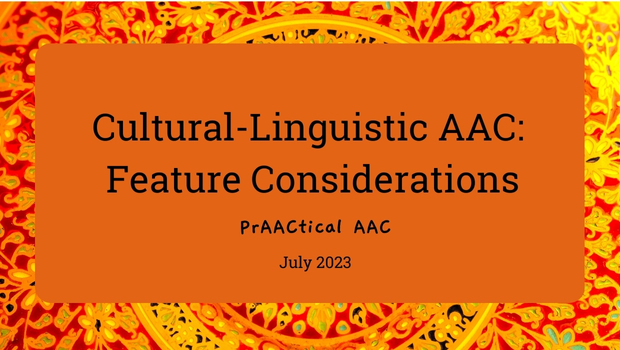
Our series on multilingual AAC support guest authored by BilingüeAAC continues. In today’s post, Sarah Lee addresses issues specific to features of AAC apps and SGDs. BilingüeAAC is a group of SLPs with a shared belief in providing evidence-based intervention strategies and resources to bilingual Spanish AAC clients, families, caregivers, and professionals.
If you are new to this series, you can check out the previous articles using the links below.
- Bilingual AAC Support from Monolingual Professionals: An Introduction
- Cultural-Linguistic AAC Intervention: A Framework for Consideration
- Gathering Information from Families with Questionnaires and Surveys
Most of us WANT to provide culturally-linguistic responsive bilingual Spanish AAC intervention, but we don’t feel confident without knowing/speaking the language. In an effort to foster Spanish heritage language development and empower the monolingual SLPs*, we have created context-specific templates using the sociocultural approach (Soto & Yu, 2014) for the monolingual English-speaking SLP*. We will be referencing these templates in today’s post. The template includes vocabulary, morphology, syntax, and social competency guidelines from:
- “An early Spanish vocabulary for children who use AAC: developmental and linguistic considerations” (Soto & Cooper, 2021)
- “Protocol for the analysis aided language samples in Spanish” (PAALS) (Soto, 2020).
- MacArthur Bates Communicative Development Inventories (MB-CDIs) Spanish edition.
- Charity Rowland’s, Communication Matrix.
*Clarification: we address the “monolingual SLPs”, however, it does not exclude bilingual SLPs of other languages nor are we stating that all non-Spanish speakers are monolingual.
An important reminder:
- SLPs must understand their client’s cultural and linguistic background to determine what is a disorder or difference (Crowley, Guest, Sudler, 2015).
- It is important to promote the client’s dual-language growth as the vocabularies in each language may be smaller, but collectively as big or bigger than their monolingual peers. This provides a richer context to what client’s know.
- Lastly, bilingualism does not cause delays or language disorders (Paradis, Genesee, Crago, 2019).
“HELP! I don’t have a Spanish-English device!”
Many communication apps and medically durable devices are available in multiple languages. Check out this airtable with a list of different apps and language availability. If you would like to know how to create a Spanish toggle button on a TouchChat system, please check out this great video.
Let’s get started!
Using the cultural-linguistic framework as a guide, we will be reviewing steps 3-7 for AAC implementation through a cultural-linguistic lens.
Step 3: Cultural-linguistic feature considerations
Consider the cultural differences for device customization.
For example:
- Skin tone
- Voice options
- Symbolset icon images reflective of the client’s culture (food: tamales, pho, lumpias, etc.)
- Ease of language progression in the home language (i.e., verb conjugation)
- Code-switch option and ability to monitor clients’ growth in code-switching
- Word finding capabilities in both languages
- Dual language orthography for literacy growth.
If you would like a checklist, you can find one here.
Step 4: Choose the activity or context
As a monolingual SLP, it is nearly impossible for me to provide bilingual AAC intervention “on the fly.” Decide during what activity you will be providing intervention.
Here I decided to provide a push-in lesson during snack. I will use the “meal times requesting” template. You can make your own Spanish/English vocabulary list using the Soto and Cooper (2021) appendix here. If you prefer using overlapping Spanish/English core words, they are available for free on our website. Direct translation of English core to Spanish is an insufficient tool as those would reflect English high-frequency words only. We strongly encourage reviewing the provided vocabulary list from Soto & Cooper (2021) and/or MacArthur Bates Communicative Inventories: Spanish.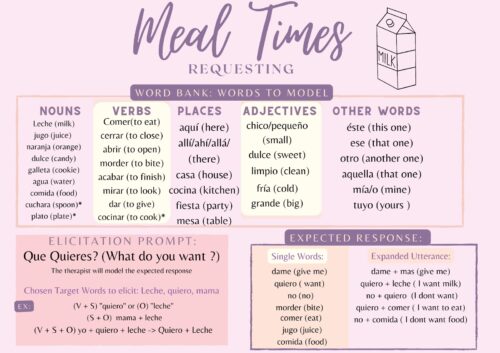
Step 5: Receptive language input
Identify the vocabulary and include the vocabulary from families/caregivers questionnaires. Notice a few of the template vocabulary words have asterisks next to them such as cuchara. The asterisks denote the need to cross-reference with the family/caregiver.
I don’t attempt to model ALL of the words every session but I pick a few for each session and add more words each session. Here, I circle all the words I would like to use for Aided language stimulation/model without expectation:
chico/pequeño, dulce, grande, mío, tuyo, otro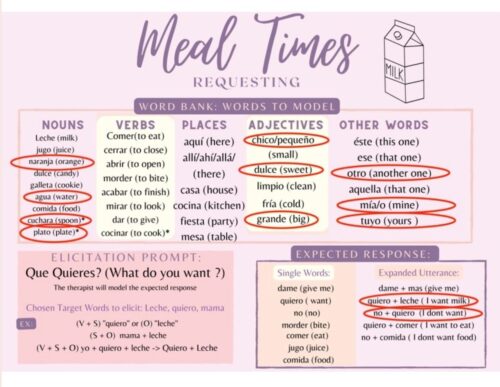
Device customization is cyclical! Check for the vocabulary within the device! Word finder may not be reliable, and you may have to look through the overlay pages.
For example, there are no search hits for mío:
But it is available under “gente”/ “people” pages.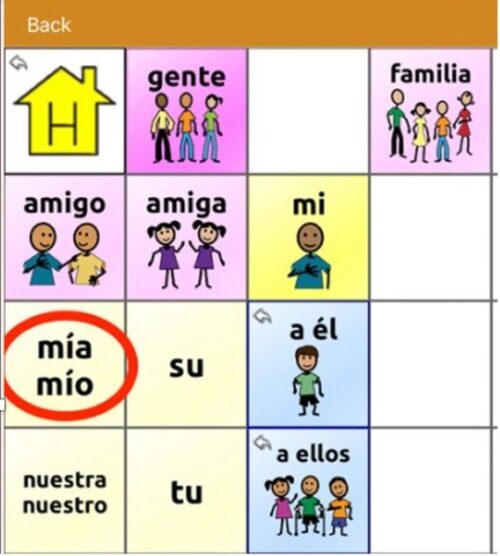
There can also be synonyms. TouchChat Wordpower 60- Español uses the word “pequeño” over “chico.”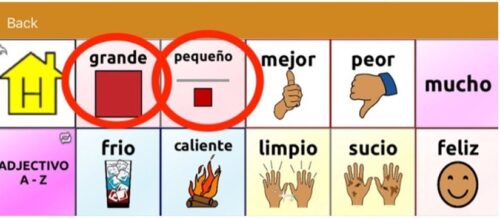
Step 6: What types of elicitation strategies will I use to encourage communication?
- Self-talk: “I’m hungry, I want to eat orange. Yo quiero naranja. (get the orange).”
- Expansion: Client says, “yo quiero naranja” and I will say “naranja es dulce” or “the orange is yours! Tuyo!
- Open-ended: What do you think? How does it taste?
- Model some choices: Dulce, guácala, yummy?
We have handouts in Spanish and English describing these strategies and many more here. Elicitation strategies, including prompt levels, are adjusted throughout the process and re-determined throughout the session.
KEY DETAIL: I am NOT a Spanish speaker. Therefore, cannot provide prompts and elicitation strategies in Spanish. I can, however, use Spanish words whenever possible in 1-2 words. I alternate between:
- Speaking in English only and MODELING/RESPONDING using Spanish device icons with Spanish voice output.
- Speaking in both languages and MODELING some words in both languages.
My goal is to provide Spanish language exposure and demonstrate the “code-switch” or toggle button on the device.
Step 7: Explicit instruction
It is important to model without expectation across a variety of contexts. However, it is also beneficial to have explicit/direct instruction and repetition (Yorke, Light, Caron, McNaughton, & Drager, 2018). Learn more about it here.
On the bottom of the templates, we provide suggested elicitation prompts and expected response.
SLP: “Que quieres? (What do you want?)
Expectant response: Quiero leche/agua/naranja/cuchara/plato
Don’t forget: WAIT. PAUSE. EXPECTANT DELAY.
“In AAC intervention, sometimes a pause is more powerful than anything we do or say…focused attention. Quiet bodies. A few seconds of silence..There is power in the perfect pause” (Zangari, 2014) In a study by Mathis, Sutherland, & McAuliffe (2011), the longer the wait time was given, the longer and more utterances were produced by the AAC user and the more likely they responded to a turn opportunity.
Don’t be overwhelmed or discouraged!
I know firsthand how difficult this is. But you are not alone! Keep practicing and you’ll get better and faster just like our AAC users. My clients and I are having fun learning AAC together.
Tips: I have said all of these with sincerity during therapy sessions, but I have found my clients really enjoy teaching and leading me. Being confused and asking for help has been a helpful elicitation strategy.
- Can you teach me how to speak Spanish?
- I’m not saying this right, can you help me?
- Wait, how do you say that in Spanish?
- Can you show me where I can find (word)?
- Where was that word again?
We hope this was helpful! Stay tuned for our next post on literacy!
Helpful websites
- BilingueAAC para padres
- Bilinguistics
- Colorin Colorado
- Hablo con CAA
- Luna Autismo
- PráctiCAAmente Conectados: CAA Con Links
- The Leaders Project
- For additional websites: www.bilingueaac.com/professionals/recursos
Helpful webinars
Helpful Instagram accounts:
- @bilingueaac
- @bilingualplaydate
- @bilingualspeechie
- @bilingualspeechresources
- @bilingualspeechtherapyworld
- @laleo.bilingual.therapy
- @LaSLPChingona
- @thebeamSLPprogram
- @theboldslpcollective
- @theholaclinic
- @lotusbloomspeech
About the Guest Author
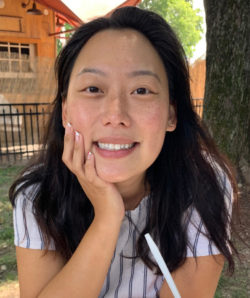
Sarah Lee is a monolingual Speech-Language Pathologist certified in NY, CA, and Or. She has worked within school and early intervention settings across all 3 states specializing in AAC. She has a Master’s of Science in Speech-Language Pathology from Western Kentucky University and a Master’s of Science in Neuroscience and Education from Teacher’s College, Columbia University. Sarah believes in evidence-based, innovative intervention strategies and synthesizing literature to practice. She manages the Instagram account, @AAC_together.
BilingüeAAC: www.BilingueAAC.com
Instagram: @bilingueaac
Facebook Group: BilingüeAAC
TPT: BilingueAAC
Filed under: Featured Posts
This post was written by Carole Zangari
